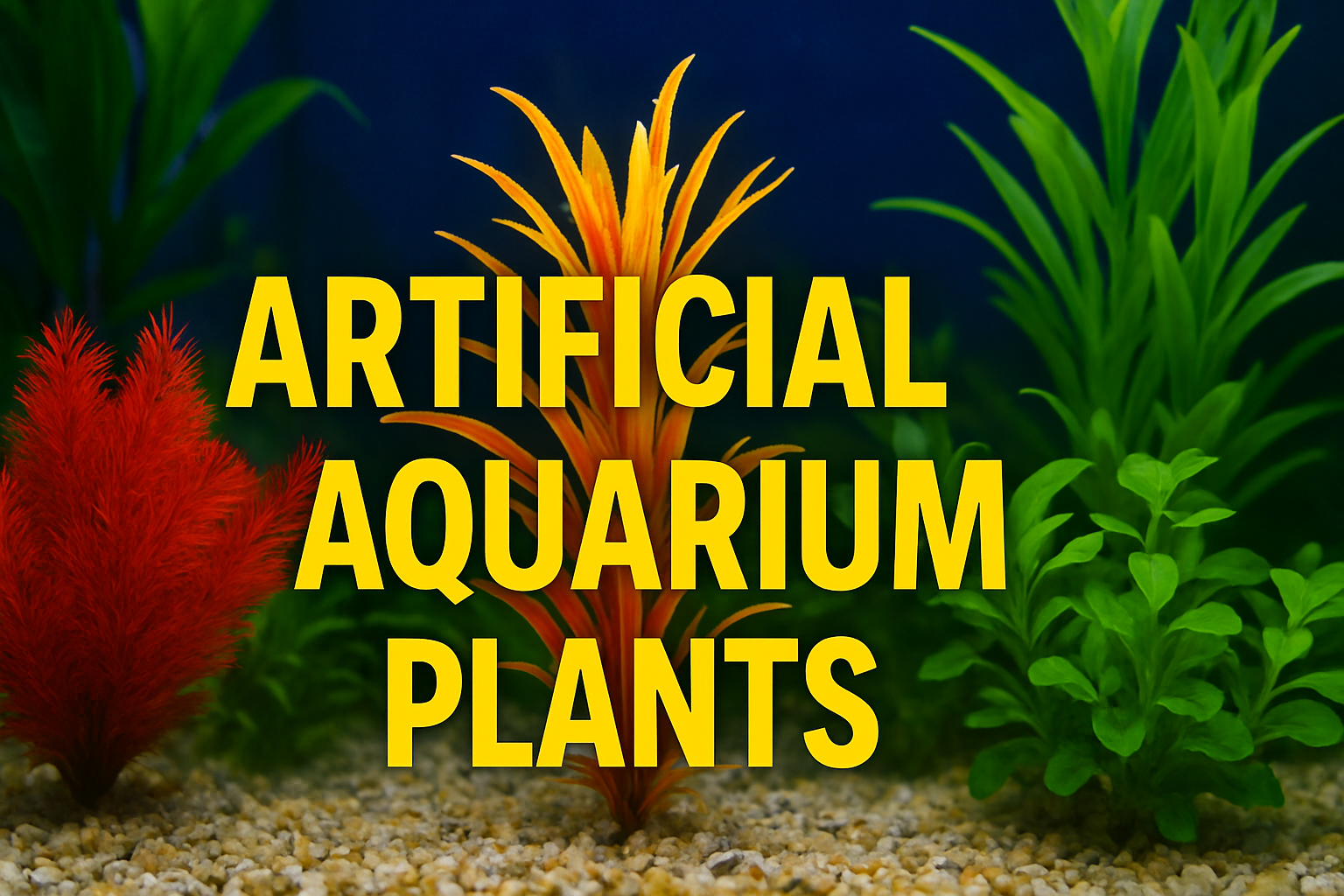Aquarium keeping is one of the most rewarding hobbies, offering a perfect blend of nature, creativity, and relaxation. When designing a beautiful tank, decorations play an important role, and plants are often at the center of aquarium design. While live plants are a natural option, artificial aquarium plants are increasingly popular due to their convenience, durability, and low maintenance.
In this comprehensive guide, we will explore everything you need to know about artificial aquarium plants: their benefits, different types, how to use them effectively, and whether they are a better choice than live plants for your setup.
What Are Artificial Aquarium Plants?
Artificial aquarium plants are decorative items designed to mimic the look of real aquatic plants. They are typically made from plastic, silk, or resin, and are available in a variety of shapes, sizes, and colors. Unlike live plants, they do not require light, nutrients, or CO₂ injection, making them a practical choice for beginners or hobbyists who prefer low-maintenance tanks.
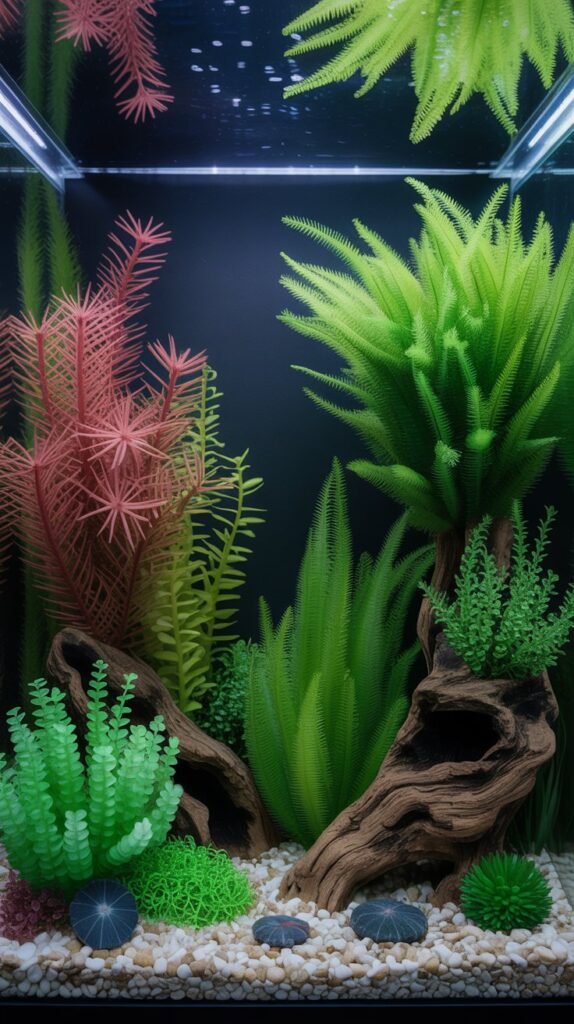
These plants can range from realistic green foliage to brightly colored fantasy designs, giving aquarists full creative control over the aesthetic of their aquarium.
Advantages of Artificial Aquarium Plants
Choosing artificial plants for your aquarium comes with many benefits, especially for new aquarists or those with limited time for tank maintenance.
1. Low Maintenance
Artificial plants don’t require trimming, fertilization, or specialized lighting. You don’t need to worry about algae growing on them or leaves decaying in your tank.
2. No Impact on Water Quality
Unlike live plants, artificial ones do not release organic waste or alter the chemical balance of your aquarium. This helps maintain stable water parameters.
3. Durable and Long-lasting
Plastic and silk plants can last for years if maintained properly. They don’t wilt, die, or get eaten by herbivorous fish.
4. Safe for All Fish Species
Some fish, such as goldfish or cichlids, tend to uproot or nibble live plants. Artificial plants are resilient and can withstand rough handling.
5. Versatility in Design
Artificial aquarium plants come in countless designs and colors. You can create natural-looking aquascapes or go for bold, creative themes using bright and unusual shades.
6. Ideal for Beginners
New aquarium owners often struggle with live plants due to lighting, nutrients, and algae problems. Artificial plants are an easy and stress-free alternative.
Disadvantages of Artificial Aquarium Plants
While artificial plants are convenient, they do come with certain drawbacks.
- Lack of Oxygen Production – Unlike live plants, they don’t photosynthesize and therefore do not provide oxygen to the water.
- No Natural Filtration – Live plants absorb nitrates and other toxins; artificial ones cannot.
- Less Natural Behavior for Fish – Some fish enjoy interacting with live plants, grazing on biofilm, or hiding within natural growth. Artificial plants cannot fully replicate this.
- Risk of Sharp Edges – Some plastic plants may have rough edges that can injure delicate fish like bettas or guppies.
Types of Artificial Aquarium Plants
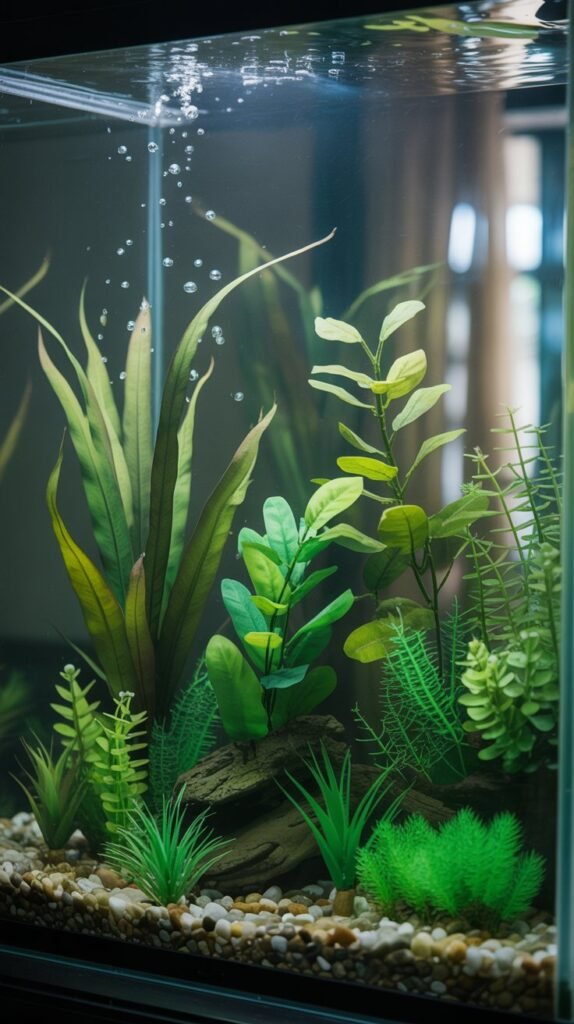
Artificial plants come in different materials and styles. Choosing the right type depends on your fish, tank theme, and personal preferences.
1. Plastic Aquarium Plants
- Most common type
- Available in both realistic and brightly colored designs
- Easy to clean and very durable
- May have sharp edges, so choose high-quality soft plastic
2. Silk Aquarium Plants
- More natural-looking than plastic
- Soft and gentle, safer for delicate fish
- Move naturally with the water current, mimicking real plants
- Slightly more expensive but worth it for realism
3. Resin or Ceramic Plants
- Often combined with decorative ornaments like driftwood or rocks
- Heavier, so they stay anchored better
- Can be used as centerpieces in aquascapes
4. Glow-in-the-Dark or LED Plants
- Designed for aesthetic appeal rather than realism
- Popular in children’s aquariums or themed tanks
- Best used sparingly to avoid looking unnatural
How to Choose Artificial Aquarium Plants
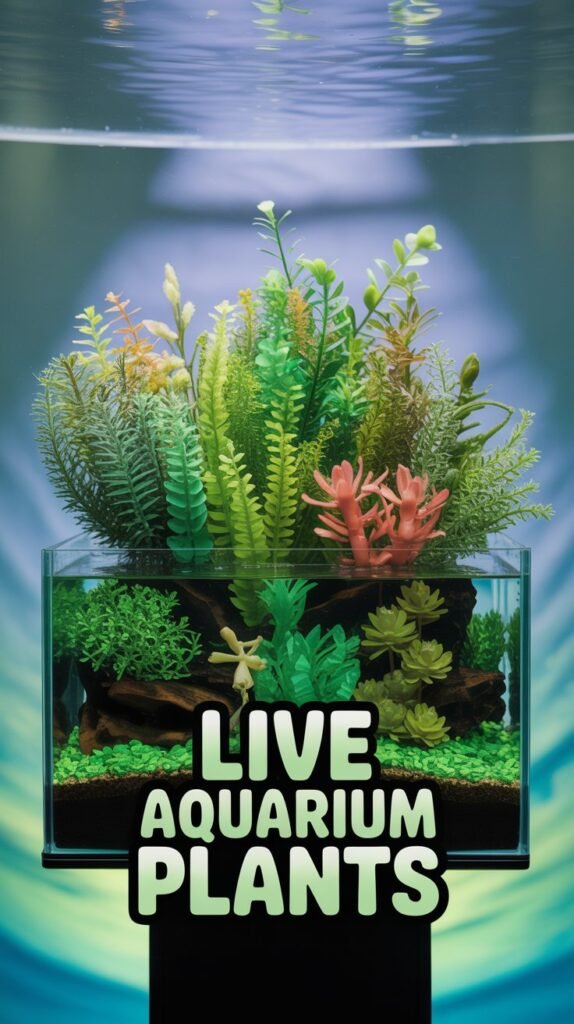
When selecting artificial aquarium plants, consider the following factors:
- Tank Size – Large plants can overwhelm small tanks, while tiny plants may look insignificant in bigger aquariums.
- Fish Species – If you keep delicate fish like bettas, opt for silk plants instead of hard plastic.
- Tank Theme – Natural green plants for realistic aquascapes, or colorful options for fantasy-style tanks.
- Anchoring – Choose plants with weighted bases or add gravel around the roots to keep them in place.
- Safety – Avoid sharp or rough plants that could injure fish.
Artificial vs. Live Aquarium Plants
Many aquarists debate between live and artificial plants. Here’s a comparison:
| Feature | Artificial Plants | Live Plants |
|---|---|---|
| Maintenance | Very low | Moderate to high |
| Oxygen Production | None | Yes |
| Water Filtration | None | Yes (absorbs nitrates) |
| Lifespan | Long-lasting | Can die or decay |
| Fish Safety | Depends on quality | Safe but may be eaten |
| Aesthetics | Realistic & fantasy options | Natural beauty |
| Beginner Friendly | Yes | Can be challenging |
Conclusion: If you want low maintenance, choose artificial plants. If you want a natural ecosystem, live plants are better.
How to Clean Artificial Aquarium Plants
To keep your artificial plants looking fresh and algae-free, follow these steps:
- Remove the Plants – Take them out of the tank gently.
- Rinse Under Warm Water – Wash off dirt and debris.
- Scrub with Soft Brush – Use a soft-bristled brush or toothbrush to remove algae buildup.
- Soak in Vinegar Solution – For stubborn stains, soak in a solution of 1 part vinegar to 3 parts water. Rinse thoroughly before returning to the tank.
- Avoid Harsh Chemicals – Never use soap or bleach directly, as residues can harm fish.
Tips for Decorating with Artificial Aquarium Plants
- Mix different sizes and shapes to create depth and layers.
- Place taller plants at the back and shorter ones in the front for a natural look.
- Combine artificial plants with rocks, driftwood, or caves for variety.
- Use silk plants in betta or guppy tanks to prevent fin damage.
- Clean plants regularly to maintain their appearance.
Best Fish for Tanks with Artificial Plants
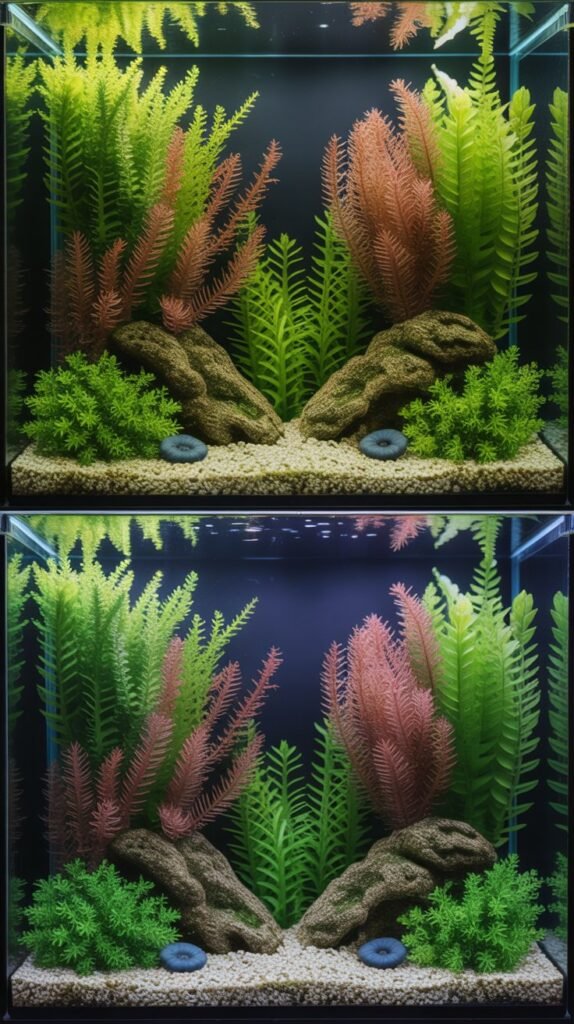
Artificial plants are safe for almost all fish, but they are especially useful for species that destroy live plants. These include:
- Goldfish – Known for nibbling on plants.
- Cichlids – Dig and uproot live plants.
- Plecos and Catfish – Often uproot soft plants while scavenging.
- Turtles – Tend to destroy live plants.
Conclusion
Artificial aquarium plants are an excellent option for aquarists who want a low-maintenance, long-lasting, and versatile way to decorate their tanks. While they lack the natural benefits of live plants, such as oxygenation and water filtration, they provide durability, safety, and endless design possibilities.
For beginners, busy hobbyists, or those keeping plant-destroying fish, artificial plants can be the perfect solution for creating a stunning aquarium.
FAQs About Artificial Aquarium Plants
Q1: Are artificial aquarium plants safe for fish?
Yes, high-quality artificial plants are safe. Just avoid cheap plastic with sharp edges that can injure fish.
Q2: Do artificial plants affect water quality?
No, they do not release toxins or alter water chemistry.
Q3: How do I keep artificial plants from floating?
Choose weighted plants or anchor them with gravel or rocks.
Q4: Can I mix live and artificial plants in one tank?
Yes, many aquarists combine both to balance aesthetics and functionality.
Q5: How often should I clean artificial aquarium plants?
Clean them every 2–4 weeks or when you notice algae buildup.
Q6: Do artificial plants look realistic?
Silk plants and high-quality plastic plants can look very close to real ones, especially when arranged properly.
Q7: Are artificial plants good for betta fish?
Yes, but silk plants are recommended since they are softer and won’t tear delicate fins.

